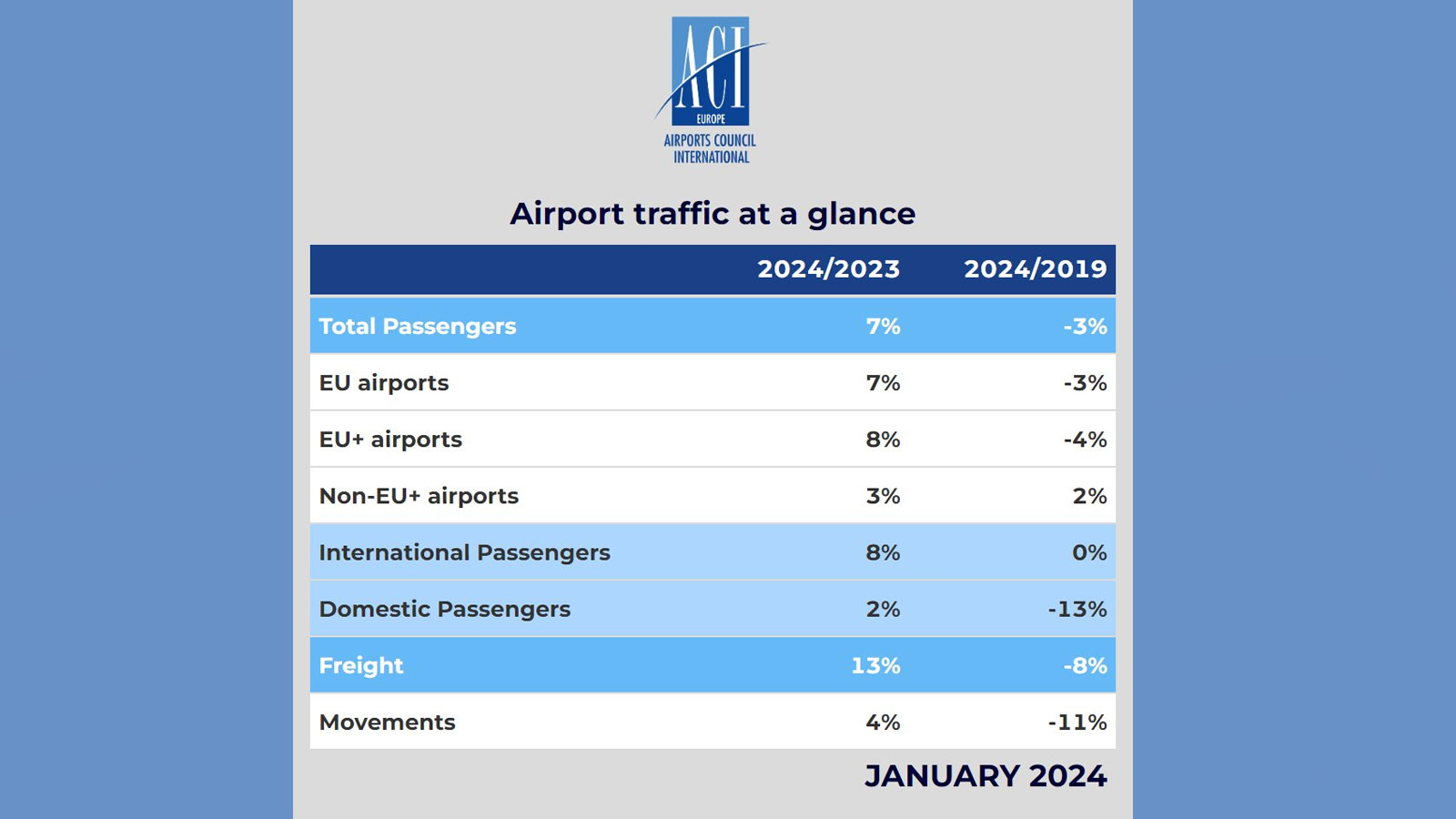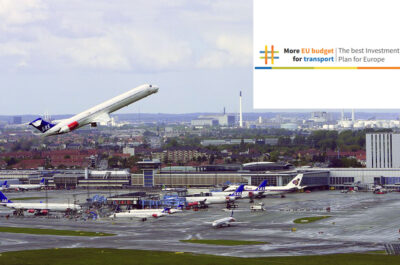
Multiple factors shaping diverse traffic performance across markets with domestic demand retreating and smaller regional airports underperforming.
BRUSSELS – European airport trade body ACI Europe released its air traffic report for January 2024. Passenger traffic across the European airport network increased by +7% in January compared to the same month last year, with the growth predominantly fuelled by international passengers (+8%) rather than domestic passengers (+2%).
As a result, passenger traffic came very close to a full recovery ‑ standing just -3% below pre-pandemic volumes (January 2019). While international passenger volumes achieved a full recovery (0%) for the first time, domestic traffic remained -13% below January 2019 levels.
Olivier Jankovec, Director General of ACI Europe commented: “Overall, January saw the recovery in passenger traffic enduring, with further growth over the past year, and international passenger traffic finally getting back to its pre-pandemic levels after 5 years. Demand generally remained resilient in the face of much increased air fares, even though the growth dynamic slowed down or even stalled in a few markets. This is adding further divergences to an already much fragmented airport market, where geopolitics and structural aviation market changes – including the primacy of leisure demand and selective Low-Cost Carrier expansion – are shaping traffic performance like never before.”
He added: “Looking at the months ahead, macro-economic conditions are set to improve in the EU and the UK in particular, with further drops in inflation and growth in real wages. Combined with consumers prioritising experiences and leisure, this should support continued growth in demand for air travel – with headwinds still coming mainly from supply pressures and higher air fares as well as geopolitics.”

Performance variations across national markets
Airports in the EU+ market1 led the passenger growth dynamic in January, at +8% over the same month last year.
Impressive results were posted by airports in Slovenia (+29.8%), the Czech Republic (+28.9%), Malta (+22.6%), Poland (+18.9%) and Hungary (+16.6%). At the other end of the spectrum, airports in Sweden (-1.3%) and the Netherlands (-0.8%) saw their passenger traffic decreasing, while growth was subdued at airports in Romania and Latvia (both at +1.3%) as well as France, Portugal and Norway (all at +1.7%).
When compared to pre-pandemic levels (January 2019), the EU+ market stood at -4%, with airports predominantly relying on leisure/VFR2 demand largely exceeding their pre-pandemic volumes: Malta (+27%), Cyprus (+21.6%), Poland (+20.5%), Croatia (+15.9%), Portugal (+14.8%), Spain (+12.7%) and Greece (+12.4%). Conversely, airports in Slovakia (-38.8%), Sweden (‑29.2%), Slovenia (-27.5%), Finland (-24.2%) and Germany (‑23.7%) remained farthest from a full recovery.
Worth noting is the retreat of domestic passenger traffic at airports in Germany (-50.9%), Sweden (-41.6%) and Finland (-31.5%) – which contributed to their overall underperformance – as well as at those in France (-30.5%) and the UK (-21.6%). This contrasts with airports in Spain (+12.9%), Portugal (+7.3%), Greece (+6.9%) and Italy (+1.3%) where domestic passenger traffic exceeded pre-pandemic levels.
Airports in the rest of Europe3 saw passenger traffic increasing by +3% in January compared to the same month last year, with impressive performances coming from those in Albania (+51.2%), North Macedonia (+47.1%), Uzbekistan (+46.1%), Georgia (37.4%), and Bosnia and Herzegovina (+26.8%).
While airports in Türkiye (+3.8%) maintained their growth dynamic despite much lower domestic volumes (-19%), Ukrainian airports remained closed for all air passenger traffic due to the ongoing war, and the conflict in Israel impacted the country’s airports heavily (‑56.3%).
When compared to pre-pandemic levels (January 2019), airports in the rest of Europe outperformed the continent’s average at +2%. Airports in Uzbekistan (+210%) have tripled their passenger volumes, followed by those in Albania (+182%), Kazakhstan (+103%), Armenia (+80%), Kosovo (+70.2%) and Serbia (+60.2%).
Performance variations across airport categories
Passenger traffic at the Majors4 expanded by +8.3% in January when compared to the same month last year on the back of strong transatlantic demand, the progressive return of Chinese travellers and network airlines adding more capacity. This resulted in the Majors achieving almost a full recovery at -1.4% compared to January 2019.
- London-Heathrow (+9.4% vs. Jan 2023 | +1.3% vs. Jan 2019) remained the busiest European airport, with Istanbul (+6.4% vs. Jan 2023 | +15% vs. 2019) coming second – welcoming just 8000 passengers less than the British hub – followed by Paris-CDG (+2.2% vs. Jan 2023 | -10.2% vs. Jan 2019).
- Madrid (+8.1% vs. Jan 2023 | +9.2% vs. Jan 2019) replaced Amsterdam (-0.9% vs Jan 2023 | -9.2% vs. Jan 2019) in the 4th
- Rome-FCO’s impressive growth (+27.9% vs. Jan 2023 | +5.2% vs. Jan 2019) boosted the performance of the Majors.
Amongst Mega and Large airports5, the highest increases in January came from Prague (+28.5% vs. Jan 2023 | -13.1% vs. Jan 2019), Warsaw (+21.5% vs. Jan 2023 | +15.5% vs. Jan 2019), Alicante (+ 20.6% vs. Jan 2023 | +22.1% vs. Jan 2019 ) and Malaga (+20.1% vs. Jan 2023 | +32.5% vs. Jan 2019).
Medium-sized airports6 registered the best passenger traffic performance, with an average increase of +9.6% in January compared with the same month last year.
This was the only segment exceeding its pre-pandemic volumes at +5% compared to January 2019. Airports reporting the highest increases in that category mostly came from the non-EU+ market: Bourgas (+105.5% vs Jan 2023 | + 7.7% vs. Jan 2019), Kutaisi (+77.7% vs. Jan 2023 | + 171.8% vs. Jan 2019), Tirana (+51.2% vs Jan 2023 | +181.5% vs. Jan 2019), Skopje (+50.5% vs. Jan 2023 | + 50.9% vs. Jan 2019), Samarkand (+46.1% vs Jan 2023 | +210.1% vs. Jan 2019) and Florence (+32.5% vs. Jan 2023 | +13.1% vs. Jan 2019).
As in the past months, larger Low-Cost bases kept outperforming when compared to pre-pandemic levels (January 2019): Memmingen (+72.3%), Beauvais (+41.3%), Bergamo (+29.5%) and Charleroi (+21.6%).
Conversely, Small airports7 registered a -0.7% decrease in passenger traffic in January when compared to the same month last year – and remained -31% below their pre-pandemic levels (January 2019).
Aircraft movements increased by +4% in January across the European airport network compared to the same period last year, and remained -11% below pre-pandemic levels (January 2019).
Data by airport groups
Throughout January, airports welcoming more than 40 million passengers per year (Majors), airports welcoming between 25 and 40 million passengers (Mega), airports welcoming between 25 and 10 million passengers (Large), airports welcoming between 1 million and 10 million passengers per year (Medium), and airports welcoming between 1000 and 1 million passengers (Small) reported an average change in passenger traffic of -1.4%, -1.8%, -9.2%, +5% and ‑ 31% ‑ as compared to their pre-pandemic (January 2019) levels.
The airports that reported the highest increases in passenger traffic (vs January 2019) are as follows:
- Majors: Istanbul IST +15.0%, Madrid MAD +9.2%, Barcelona BCN +7.1%, Rome FCO +5.2%, London LHR +1.3%.
- Mega: Athens ATH +15.0%, Istanbul SAW +14.3%, Lisbon LIS +14.2%, Antalya AYT +9.7%, Palma de Mallorca PMI +6%.
- Large: Sochi AER +95%, Málaga AGP +32.5%, Milan Bergamo BGY +29.5%, Catania CTA +24.5%, Alicante ALC +22.1%.
- Medium: Samarkand SKD +210.1%, Tirana TIA +181.5%, Kutaisi KUT +171.8%, Almaty ALA +109.2%, Astana NQZ +95.0%.
- Small: Kramfors KRF +144.4%, Babimost IEG +139.7%, Porto Santo PXO +88.8%, Sitia JSH +87.5%, Batumi BUS +82.7%.
1. EU, EEA, Switzerland and UK.
2. Visiting Friends and Relatives
3. Albania, Armenia, Belarus, Bosnia & Herzegovina, Georgia, Israel, Kazakhstan, Kosovo, North Macedonia, Moldova, Montenegro, Russia, Serbia, Turkey, Ukraine and Uzbekistan.
4. Airports with more than 40 million passengers per annum (2023).
5. Airports with 10 to 40 million passengers per annum (2023)
6. Airports with 1 to 10 million passengers per annum (2023)
7. Airports with less than 1 million passengers per annum (2023).
Vicky is the co-founder of TravelDailyNews Media Network where she is the Editor-in Chief. She is also responsible for the daily operation and the financial policy. She holds a Bachelor's degree in Tourism Business Administration from the Technical University of Athens and a Master in Business Administration (MBA) from the University of Wales.
She has many years of both academic and industrial experience within the travel industry. She has written/edited numerous articles in various tourism magazines.





























































































































































































